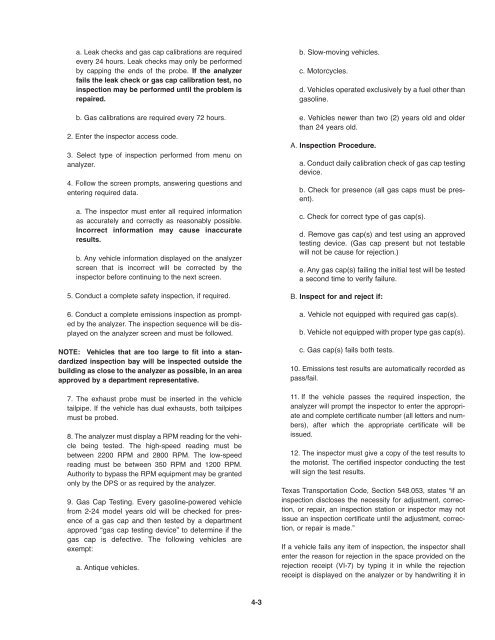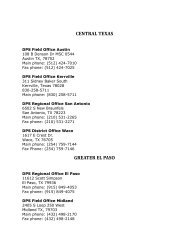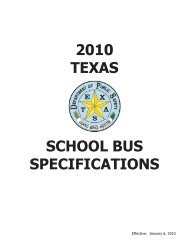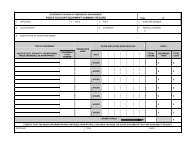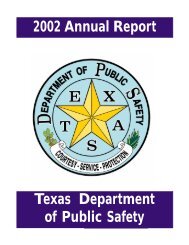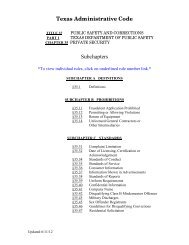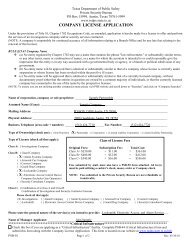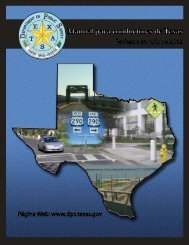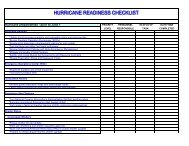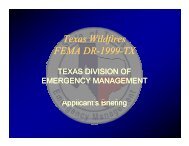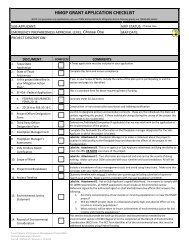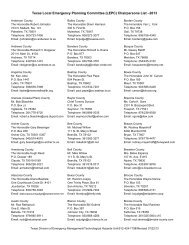Vehicle Emissions Inspection & Maintenance Rules & Regulations
Vehicle Emissions Inspection & Maintenance Rules & Regulations
Vehicle Emissions Inspection & Maintenance Rules & Regulations
Create successful ePaper yourself
Turn your PDF publications into a flip-book with our unique Google optimized e-Paper software.
a. Leak checks and gas cap calibrations are requiredevery 24 hours. Leak checks may only be performedby capping the ends of the probe. If the analyzerfails the leak check or gas cap calibration test, noinspection may be performed until the problem isrepaired.b. Gas calibrations are required every 72 hours.2. Enter the inspector access code.3. Select type of inspection performed from menu onanalyzer.4. Follow the screen prompts, answering questions andentering required data.a. The inspector must enter all required informationas accurately and correctly as reasonably possible.Incorrect information may cause inaccurateresults.b. Any vehicle information displayed on the analyzerscreen that is incorrect will be corrected by theinspector before continuing to the next screen.5. Conduct a complete safety inspection, if required.6. Conduct a complete emissions inspection as promptedby the analyzer. The inspection sequence will be displayedon the analyzer screen and must be followed.NOTE: <strong>Vehicle</strong>s that are too large to fit into a standardizedinspection bay will be inspected outside thebuilding as close to the analyzer as possible, in an areaapproved by a department representative.7. The exhaust probe must be inserted in the vehicletailpipe. If the vehicle has dual exhausts, both tailpipesmust be probed.8. The analyzer must display a RPM reading for the vehiclebeing tested. The high-speed reading must bebetween 2200 RPM and 2800 RPM. The low-speedreading must be between 350 RPM and 1200 RPM.Authority to bypass the RPM equipment may be grantedonly by the DPS or as required by the analyzer.9. Gas Cap Testing. Every gasoline-powered vehiclefrom 2-24 model years old will be checked for presenceof a gas cap and then tested by a departmentapproved “gas cap testing device” to determine if thegas cap is defective. The following vehicles areexempt:a. Antique vehicles.b. Slow-moving vehicles.c. Motorcycles.d. <strong>Vehicle</strong>s operated exclusively by a fuel other thangasoline.e. <strong>Vehicle</strong>s newer than two (2) years old and olderthan 24 years old.A. <strong>Inspection</strong> Procedure.a. Conduct daily calibration check of gas cap testingdevice.b. Check for presence (all gas caps must be present).c. Check for correct type of gas cap(s).d. Remove gas cap(s) and test using an approvedtesting device. (Gas cap present but not testablewill not be cause for rejection.)e. Any gas cap(s) failing the initial test will be testeda second time to verify failure.B. Inspect for and reject if:a. <strong>Vehicle</strong> not equipped with required gas cap(s).b. <strong>Vehicle</strong> not equipped with proper type gas cap(s).c. Gas cap(s) fails both tests.10. <strong>Emissions</strong> test results are automatically recorded aspass/fail.11. If the vehicle passes the required inspection, theanalyzer will prompt the inspector to enter the appropriateand complete certificate number (all letters and numbers),after which the appropriate certificate will beissued.12. The inspector must give a copy of the test results tothe motorist. The certified inspector conducting the testwill sign the test results.Texas Transportation Code, Section 548.053, states “if aninspection discloses the necessity for adjustment, correction,or repair, an inspection station or inspector may notissue an inspection certificate until the adjustment, correction,or repair is made.”If a vehicle fails any item of inspection, the inspector shallenter the reason for rejection in the space provided on therejection receipt (VI-7) by typing it in while the rejectionreceipt is displayed on the analyzer or by handwriting it in4-3


